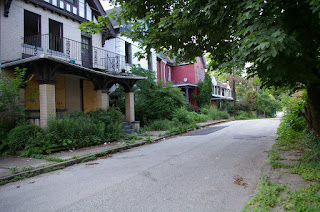This lot was covered with ivy before our landlord, a few neighbors, and my boyfriend and I ripped it all out. A friend helped us truck in some leaf mold for mulch and topsoil for the beds from
Agrecycle, an awesome composting haven in the Point Breeze neighborhood of Pittsburgh. We are just making a dent in the back of the lot for some vegetables this season, but hope even more community involvement next season can turn it into a real community garden and community space. I am posting a picture of the beds mainly for you, dad! My dad and I built raised beds when I was in middle school in eastern Tennessee because our "soil" was nothing more than red clay that crabgrass and kudzu liked to grow in, but not much else. Well, these beds are cobbled together with scrap materials and a tad shaky, but I think they'll last at least one season before we have to reassemble them. The warped lumber we found in an abandoned garage at the back of the property and the bricks and cinder-blocks we collected from the local construction-material-reuse center, Construction Junction, also located in Point Breeze. A few days ago we had a massive hail storm that did a little damage, but overall, i think the plants like their new home. This picture is a few weeks old, so the little buggers are bigger now, and the aphids and flea beetles are more
prevalent. A soapy spray of water, a bit of
castile soap, and a tablespoon or two of vegetable oil has kept them at bay though. It smothers the poor little guys, but it is a
necessary evil before they smother the
tomato leaves.


































